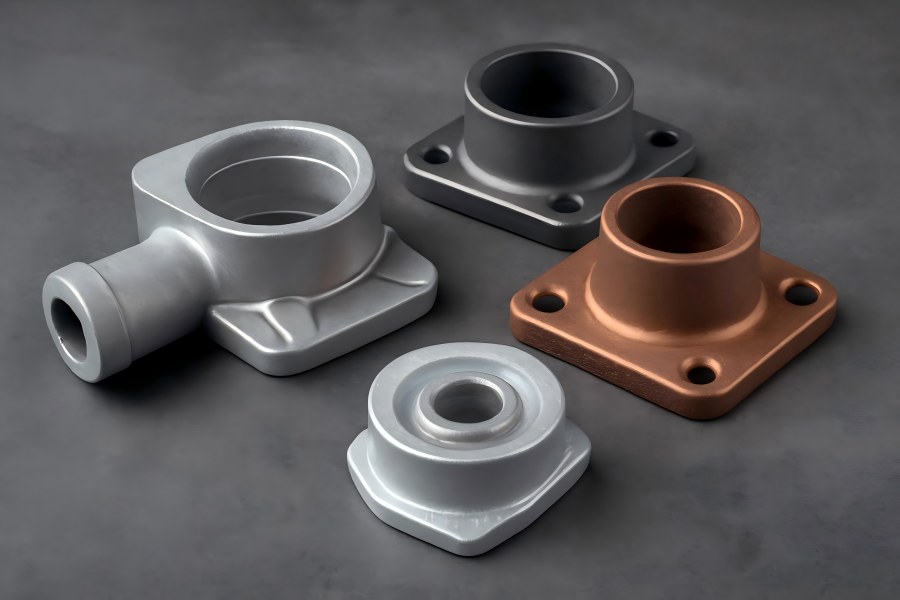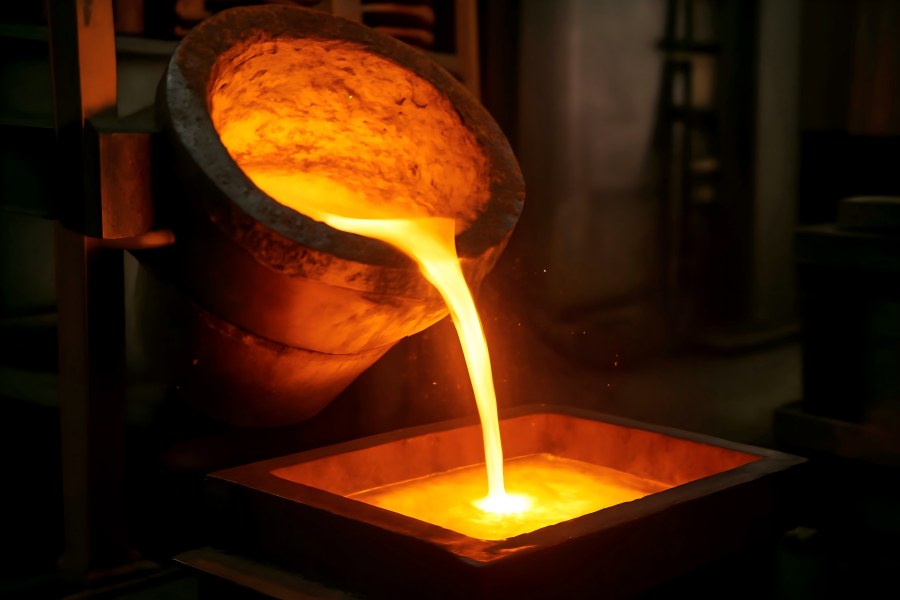One of the most important procedures in precise production is gravity die casting. This process, which is widely used in sectors including automotive, aerospace, and medical devices, provides an affordable and dependable way to produce metal parts with exceptional mechanical qualities and high precision.
This guide will delve into the fundamental aspects of gravity die casting, exploring its process, advantages, challenges, and applications, while also highlighting best practices for achieving the highest-quality castings.
What is Gravity Die Casting?
In gravity die casting, sometimes referred to as permanent mold casting, molten metal is poured into a mold cavity as gravity acts as a force. The process is called “gravity die casting” because the metal is poured into the mold cavity solely by gravity, without the application of any external force. This process creates metal castings with precise details and complex designs.
Key Characteristics of Gravity Die Casting:
- Mold Type: It uses a reusable metal mold, which distinguishes it from sand casting and other casting methods that use expendable molds.
- Metal Flow: The molten metal flows into the mold cavity by gravity, without the need for high pressure.
- Cooling Process: After pouring the metal into the mold, it is allowed to cool and solidify, after which the mold is opened to eject the finished casting.
There are two primary types of molds used in gravity die casting:
- Hot-Chamber Molds: These are preheated molds where molten metal is poured directly into the cavity. For metals like aluminum that have lower melting points, hot-chamber casting is frequently employed.
- Cold-Chamber Molds: These are used for metals with higher melting points, such as steel and copper alloys, where the metal is poured from a separate furnace into the mold cavity.
The Gravity Die Casting Process
The gravity die casting process consists of several key steps, each of which plays a vital role in producing high-quality castings. Let’s dissect each step of the procedure:
- Mold Preparation: The metal mold must first be prepared. This includes ensuring the mold is clean, free of defects, and coated with a release agent to facilitate easy ejection of the casting once it has cooled.
- Pouring Molten Metal: The molten metal flows into the mold cavity, driven by gravitational force. The metal is heated to a specific temperature, depending on the material being cast, and poured through a sprue into the mold cavity.
- Cooling and Solidification: When the mold is full, the molten metal is let to cool and solidify. Careful control is necessary to prevent problems like shrinkage or cracks because the cooling rate can have a major impact on the casting’s mechanical qualities.
- Casting Ejection: The mold is opened and the casting is taken out once the metal has cooled and set. To get the desired final product, extra finishing procedures like machining, polishing, or coating could be needed, depending on how intricate the object is.
Materials Used in Gravity Die Casting

The materials used in gravity die casting can vary depending on the desired characteristics of the finished product. Nonetheless, some typical resources are as follows:
- Aluminum Alloys: Because of its superior mechanical qualities, low weight, and resistance to corrosion, aluminum is one of the most commonly used materials in gravity die casting. Aluminum alloys 356, 380, and 413 are common.
- Copper Alloys: Copper is used when high strength and conductivity are required. Copper alloys such as bronze and brass are commonly used in gravity die casting for parts like valves, fittings, and electrical components.
- Steel Alloys: Steel, including stainless steel and carbon steel, is often used in gravity die casting for high-strength applications that require durability and resistance to wear.
- Zinc Alloys: Zinc is another popular material, particularly in die-casting processes, due to its low melting point and good fluidity.
Advantages of Gravity Die Casting
Gravity die casting offers several key advantages over other casting methods, making it an attractive choice for manufacturers in various industries. Some of the most significant advantages include:
- High Precision and Accuracy: The use of permanent molds allows for tight tolerances and high-dimensional accuracy in the finished product, which is crucial for industries that demand precision.
- Improved Mechanical Properties: Castings made through gravity die casting often exhibit superior mechanical properties, such as strength and fatigue resistance, due to the controlled cooling and solidification process.
- Cost-Effective for Medium to High-Volume Production: Although the initial cost of creating the mold can be high, gravity die casting is an economical choice for medium to high-volume production, as the molds can be reused multiple times.
- Improved Surface Finish: Post-casting operations like polishing and grinding are less necessary since gravity die casting’s solidification process produces a smooth surface finish.
Difficulties in Gravity Die Casting
Although gravity die casting has many advantages, there are drawbacks as well. Some common issues that manufacturers may face include:
- Shrinkage and Porosity: As the molten metal cools and solidifies, shrinkage can occur, leading to voids or porosity within the casting. Careful control of cooling rates and mold design can help mitigate this issue.
- Thermal strains and Cracking: The casting may experience fractures or distortion as a result of thermal strains brought on by rapid or uneven cooling. Proper mold design and cooling techniques are essential to prevent these problems.
- Design Limitations: Gravity die casting is best suited for parts with moderate complexity. Very intricate designs or undercuts may not be feasible without the use of additional processes such as sand casting or investment casting.
Applications of Gravity Die Casting
Many industries utilize gravity die casting to create components with high strength and precision. The following are a few typical applications:
- Automotive: Because strength and precision are required, gravity die casting is frequently used to create parts including engine blocks, transmission housings, and brake components.
- Aerospace: Gravity die casting is used for producing critical components in the aerospace industry, such as engine parts, brackets, and structural components that require high-performance standards.
- Medical Devices: Components such as housings for medical equipment and surgical tools can be manufactured using gravity die casting to meet strict quality and precision requirements.
- Industrial Equipment: Gravity die casting is also commonly used to produce components for industrial machinery, valves, pumps, and other heavy-duty equipment.
Factors Affecting Gravity Die Casting Quality
Several factors can influence the quality of castings produced through gravity die casting. Some of the most important factors include:
- Mold Design and Material: The quality and design of the mold significantly impact the casting’s quality. Achieving high-quality castings requires consideration of variables like ventilation, mold coating, and mold material type.
- Pouring Temperature and Metal Flow: The flowability of the molten metal and the final casting quality can be affected by the temperature at which the metal is poured. If it’s too cold, the metal can solidify before it fills the mold chamber.
- Cooling Rate and Solidification Process: To avoid flaws like porosity, cracks, or shrinkage, the cooling rate needs to be carefully managed. Uniform cooling helps ensure the mechanical properties of the casting are consistent.
Maintenance of Gravity Die Casting Equipment
Maintaining the equipment and molds used in gravity die casting is crucial for ensuring the longevity of the process and the quality of the castings. Here are some key maintenance practices:
- Routine Mold Maintenance: Molds must be regularly cleaned and checked for wear and tear. This includes re-coating the molds with release agents and repairing any defects that may affect casting quality.
- Cleaning and Re-Coating Molds: To get rid of any remaining metal or impurities, the molds should be cleaned on a regular basis. They should also be re-coated with a release agent to prevent sticking and ensure easy ejection of the casting.
- Troubleshooting Common Issues: Identifying and addressing issues such as excessive porosity, cracks, or surface defects early can prevent delays in production and improve overall quality.
Future Trends in Gravity Die Casting
As technology continues to evolve, so does gravity die casting. Here are some future trends to look out for:
- Innovations in Mold Materials and Coatings: New mold materials and coatings are being developed to improve mold longevity, reduce defects, and enhance casting quality.
- Advancements in Automation and Robotics: The incorporation of robotics and automation into the gravity die casting process allows for greater precision, higher throughput, and reduced labor costs.
- Sustainability and Eco-Friendly Practices: With growing environmental concerns, there is an increasing push for sustainable practices in manufacturing. Gravity die casting can benefit from improved recycling methods, energy-efficient processes, and reduced material waste.
